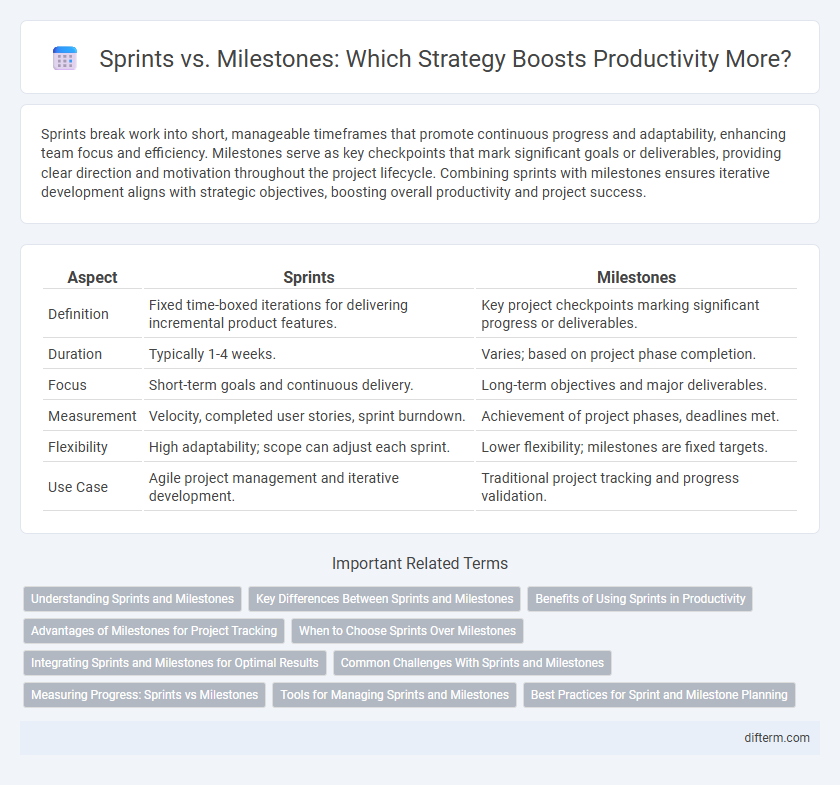Sprints break work into short, manageable timeframes that promote continuous progress and adaptability, enhancing team focus and efficiency. Milestones serve as key checkpoints that mark significant goals or deliverables, providing clear direction and motivation throughout the project lifecycle. Combining sprints with milestones ensures iterative development aligns with strategic objectives, boosting overall productivity and project success.
Table of Comparison
| Aspect | Sprints | Milestones |
|---|---|---|
| Definition | Fixed time-boxed iterations for delivering incremental product features. | Key project checkpoints marking significant progress or deliverables. |
| Duration | Typically 1-4 weeks. | Varies; based on project phase completion. |
| Focus | Short-term goals and continuous delivery. | Long-term objectives and major deliverables. |
| Measurement | Velocity, completed user stories, sprint burndown. | Achievement of project phases, deadlines met. |
| Flexibility | High adaptability; scope can adjust each sprint. | Lower flexibility; milestones are fixed targets. |
| Use Case | Agile project management and iterative development. | Traditional project tracking and progress validation. |
Understanding Sprints and Milestones
Sprints are short, time-boxed periods typically lasting 1 to 4 weeks, during which specific tasks or features are developed and completed to maintain steady progress in agile project management. Milestones mark significant points or achievements within a project timeline, serving as checkpoints to evaluate progress against strategic goals. Understanding the difference between sprints and milestones enables teams to effectively plan iterative work cycles while tracking long-term project objectives.
Key Differences Between Sprints and Milestones
Sprints are time-boxed periods in Agile project management focused on delivering specific features or tasks, typically lasting 1 to 4 weeks. Milestones represent significant points or achievements in a project timeline, marking the completion of major phases or deliverables without a fixed duration. While sprints emphasize iterative progress and continuous delivery, milestones serve as checkpoints to assess overall project status and alignment with goals.
Benefits of Using Sprints in Productivity
Sprints enhance productivity by breaking projects into focused, time-boxed intervals that foster rapid progress and adaptability. This iterative approach enables teams to prioritize tasks, minimize bottlenecks, and deliver incremental value consistently. Emphasizing frequent review cycles, sprints improve collaboration, agility, and overall project transparency compared to traditional milestone-based methods.
Advantages of Milestones for Project Tracking
Milestones provide clear, quantifiable checkpoints that simplify project tracking and enhance visibility of progress for all stakeholders. They enable teams to quickly identify project phases completion, detect delays early, and allocate resources more efficiently. By breaking down complex projects into manageable goals, milestones promote accountability and align efforts toward timely project delivery.
When to Choose Sprints Over Milestones
Choose sprints over milestones when projects require iterative progress and frequent reassessment to maintain agility and adapt quickly to changes. Sprints provide short, manageable time-boxed intervals, typically 1-4 weeks, enabling teams to deliver incremental value and gather regular feedback. This approach suits dynamic environments where continuous improvement and rapid delivery outweigh fixed deadline tracking found in milestone-driven workflows.
Integrating Sprints and Milestones for Optimal Results
Integrating sprints and milestones enhances productivity by aligning short-term agile cycles with long-term project goals, ensuring continuous progress while tracking key deliverables. Sprints facilitate iterative development and rapid feedback, while milestones mark critical achievements and decision points, providing a structured timeline for project evaluation. Combining these approaches promotes efficient resource allocation and improved team accountability, driving projects to successful and timely completion.
Common Challenges With Sprints and Milestones
Sprints often face challenges such as scope creep, time constraints, and team burnout, which can hinder productivity and goal completion. Milestones may suffer from poor alignment with overall project objectives, leading to missed deadlines and reduced motivation. Both sprints and milestones require clear communication and realistic planning to overcome these common obstacles and ensure continuous progress.
Measuring Progress: Sprints vs Milestones
Measuring progress through sprints allows teams to track incremental achievements in short, fixed intervals, fostering continuous feedback and adaptability. Milestones serve as significant checkpoints that mark the completion of major project phases, providing clear indicators of overarching goals met. Combining sprints and milestones enables precise monitoring of both detailed tasks and critical project outcomes, enhancing overall productivity and goal alignment.
Tools for Managing Sprints and Milestones
Tools for managing sprints and milestones streamline project tracking and enhance team productivity by providing real-time visibility into progress and deadlines. Agile project management platforms like Jira, Trello, and Asana offer features such as customizable boards, task prioritization, and timeline views tailored to sprint planning and milestone tracking. These tools integrate collaboration, automated notifications, and reporting capabilities that optimize workflow efficiency and ensure alignment with project goals.
Best Practices for Sprint and Milestone Planning
Sprint planning requires clear goal setting with manageable, time-boxed tasks that enhance team focus and iterative progress. Milestone planning emphasizes defining major project deliverables and deadlines to align stakeholders and track long-term objectives effectively. Combining precise sprint goals with well-defined milestones ensures continuous productivity and successful project delivery.
Sprints vs Milestones Infographic

 difterm.com
difterm.com